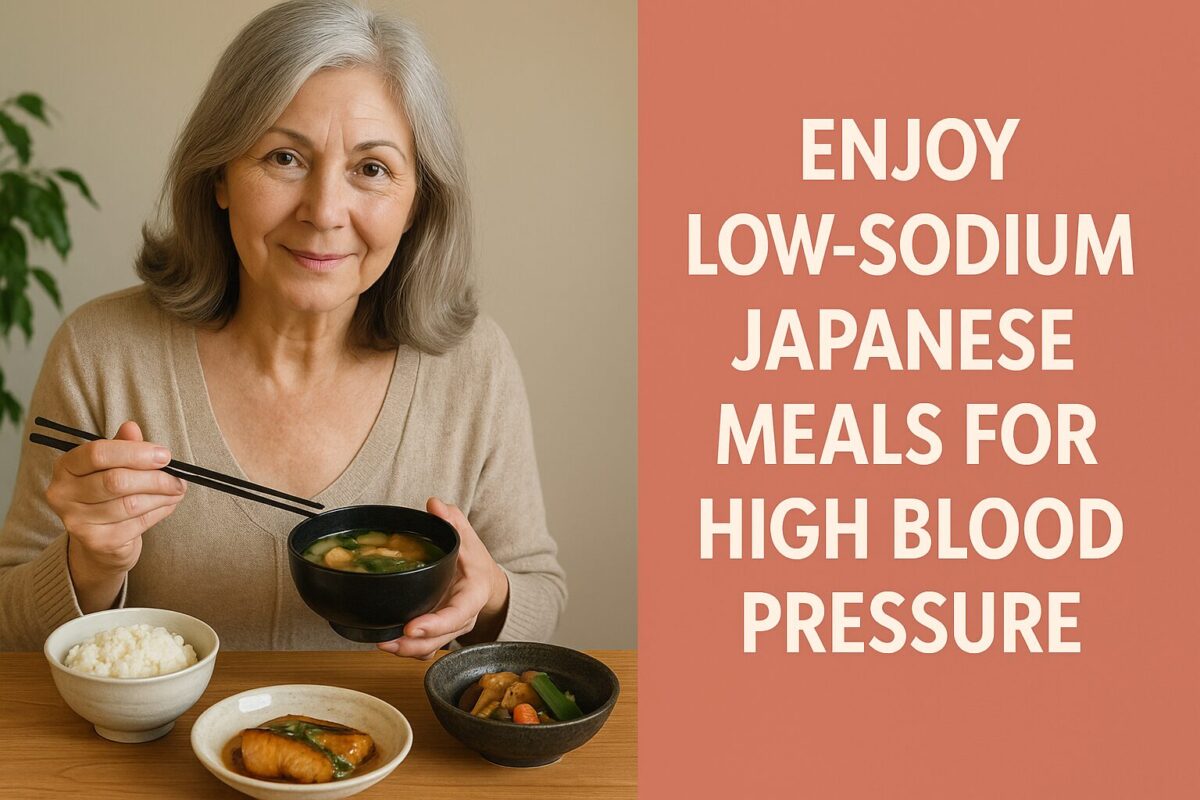Managing high blood pressure doesn’t mean giving up flavorful food. Japanese cuisine, known for its umami-rich, low-fat, and plant-forward approach, offers a wealth of delicious low-sodium meal options. Especially for older women, embracing these meals can support heart health without sacrificing taste.
Why Japanese Cuisine Is Ideal for Managing High Blood Pressure
Naturally Low in Sodium (When Prepared Right)
Traditional Japanese meals often emphasize balance and simplicity. Instead of relying on heavy seasoning, dishes draw flavor from ingredients like seaweed, mushrooms, and fermented foods. When prepared mindfully, they become excellent low-sodium options.
Rich in Heart-Healthy Ingredients
Key components like tofu, seaweed, vegetables, and fish provide protein, fiber, and essential nutrients. Many of these foods have been linked to lower blood pressure and improved cardiovascular health.
Top Low-Sodium Japanese Ingredients That Support Heart Health
Kombu and Shiitake (for Dashi)
Instead of salt or bouillon cubes, Japanese cooks use dashi, a broth made from kombu (kelp) and shiitake mushrooms. This creates deep umami flavor without added sodium.
- Where to buy: Look for kombu and dried shiitake at Asian grocery stores or online retailers like H Mart or Amazon.
- Western tip: Use dashi as a base for risottos or vegetable soups.
Tofu
Tofu is high in protein, low in sodium, and incredibly versatile. Choose fresh or silken tofu and avoid pre-seasoned varieties.
- Western tip: Add to smoothies, grain bowls, or stir-fries instead of cheese or cream-based ingredients.
Hijiki and Wakame
These sea vegetables are rich in minerals and fiber. They also add a satisfying texture to salads and soups.
- Where to buy: Available dried at Whole Foods, Japanese markets, or online.
- Western tip: Mix with quinoa or chickpea salads for a coastal, savory touch.
Eggplant, Daikon, and Green Leafy Vegetables
Common in Japanese side dishes, these vegetables help regulate sodium levels naturally due to their potassium content.
Easy Low-Sodium Japanese Recipes You Can Make at Home
Miso Soup with Homemade Dashi
Use kombu and shiitake for the broth. Add tofu cubes, wakame, and a small amount of low-sodium miso.
Simmered Eggplant (Nasu no Nimono)
Sauté eggplant in a little sesame oil and simmer with dashi and a dash of mirin and soy sauce (or low-sodium tamari).
Cold Tofu with Ginger and Scallion (Hiyayakko)
Top fresh tofu with grated ginger, scallions, and a drizzle of low-sodium soy sauce.
Steamed Vegetables with Sesame Sauce (Goma-ae)
Blanch spinach or green beans and mix with a paste of ground sesame seeds, mirin, and a tiny amount of miso.
Hijiki Salad
Rehydrate hijiki, then toss with shredded carrots, edamame, and a light sesame dressing.
Smart Tips to Reduce Salt Without Sacrificing Umami
Use Dashi as a Flavor Foundation
Dashi enhances flavor without salt. Make it in batches and freeze portions for quick use.
Embrace Fermented Ingredients (Carefully)
Miso and soy sauce can be high in sodium, but used sparingly, they add depth. Opt for low-sodium versions when available.
Enhance Flavor with Aromatics
Ginger, garlic, scallions, and citrus zest can brighten dishes without added salt.
Limit Processed Additions
Skip store-bought sauces or seasoning blends unless labeled low-sodium.
How a Low-Sodium Japanese Diet Can Improve Blood Pressure Naturally
Studies show traditional Japanese eating habits correlate with lower rates of hypertension. A focus on vegetables, fermented foods, and seafood—paired with smaller portions and minimal saturated fat—supports better heart health.
According to the American Heart Association, reducing sodium intake can significantly lower blood pressure. Incorporating Japanese meals a few times a week is a delicious way to make that change.
By choosing low-sodium Japanese ingredients and preparing them simply, older women can enjoy flavorful meals that nourish both body and heart. Whether it’s miso soup on a chilly day or a refreshing tofu salad in summer, these dishes offer both comfort and wellness.
Take the Benefit of Miso by a Supplement
Miso is one of the examples of the Japanese healthy diet. If you want to experience the health benefits of miso dishes but find the unique taste of fermented foods challenging, a natural supplement might be the perfect solution. Juveriente® offers Effisoy®, a supplement that provides the key health benefits of miso through an extract of fermented soybean germ.
Effisoy® is the only supplement outside of Japan that uses ingredients derived from fermented soybeans, bringing the wellness advantages of miso to those who may not enjoy its traditional flavor. Since its launch in 2016, it has gained popularity as a natural menopause relief supplement, helping to balance hormones and improve overall well-being.
Effisoy® works by enhancing the body’s natural synthesis of DHEA, a hormone precursor. This safe and natural boost helps regulate hormonal balance, potentially improving skin health and reducing menopause symptoms. While it benefits both men and women, it has become particularly popular among women seeking relief from menopause-related issues.
Here are some of the real product reviews in our Amazon shop.
“Restful sleep finally!!”, “I Am Now Free of Hot Flashes!!”, “Lifesaver”








